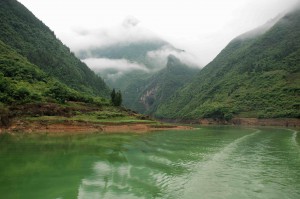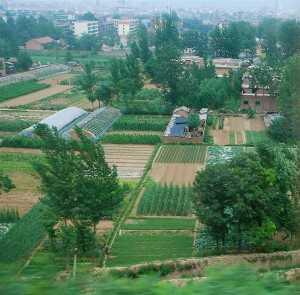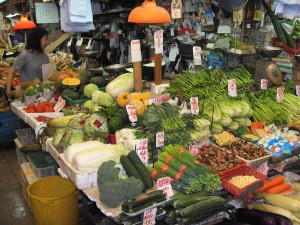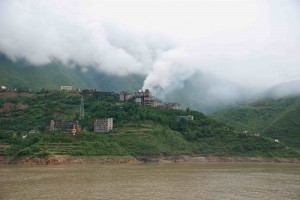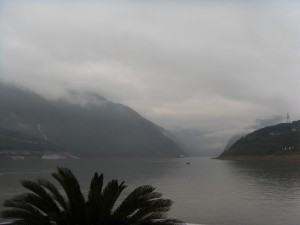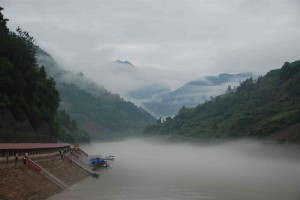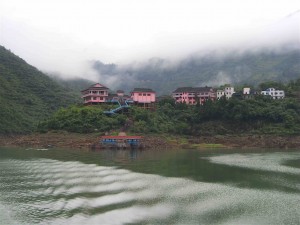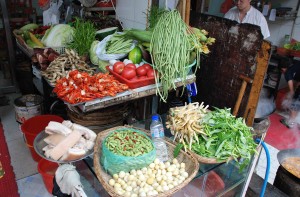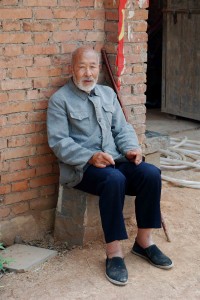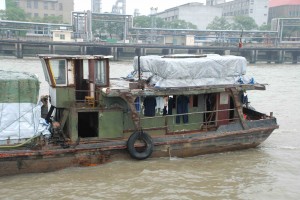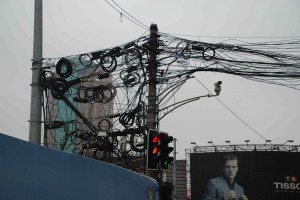Thank you for your interest in this site. Please note that all images are copyright protected and not available for use without permission. Please contact journeys@tenthousandcranes.com for any inquiries about the information contained in this site.
____________________________________________________________
I sit presently on the upper deck of our ship, cruising the Yangtze River, while steep, wetted rock walls embrace our path along this green river and waterfalls toss themselves down the cliff sides in narrow ribbons of white against black and white walls covered in clinging green. We are in the Three Gorges area and it is indeed magical. We are above the now infamous, though not yet fully operational, Three Gorges Dam, where already rising water has flooded the river valley in its quest to become a 385-mile-long reservoir that has tamed an otherwise wild river.
The arrival to the River was less pleasant than other segments of the journey. A long train ride on what was definitely NOT one of China’s finest found me in soft sleepers, this time 4-person berths with compartment doors that actually can be closed. None of the lights worked, the bedding had been used multiple times, the squat toilet areas were a fright, and the kitchen was of such concern that we all opted for packaged food. Seems there are considerable variations in trains, even though I was in the best compartment with the soft sleeper ticket rather than the previous hard sleeper of 6 berths and no compartment door (then there is hard seat, which is no more than benches – a difficult way to travel on overnight journeys and one that finds passengers sleeping in piles on floors anywhere possible). Ah, spoiled I had been by earlier railed transport. Though “No Smoking” signs abounded, they were totally ignored by staff and passengers as ash flicking on the carpeting within one’s cabin seemed to rival card playing as the best pastime.
Each compartment does come equipped with a thermos, which will actually keep water hot for hours. So there we have a trade off: marvelous thermos on lousy train. But passengers and hundreds of thermoses all arrived safely at our destination, so all was not lost.
Travel through the countryside continues to amaze me. Even as a Geographer, I had not grasped the extent of agriculture in China. I have only traveled so far through the temperate southern provinces that are sandwiched between the Li and Yangtze River Valleys, but I just don’t know when I’ve seen so much continuous green. I think I had expected more isolated groups of farming villages, not the seemingly uninterrupted agricultural endeavor that is the mainstay of this amazing country.
Agriculture is always tidy and organized in neat rows and small plots of a variety of produce. While I have not seen vast amounts of farm product prepared for transport to elsewhere in the country, it must be. I have only seen it flood into different local markets and onto street stands and carts, where it somehow disappears with the passage of the day. The volume of produce grown and consumed is beyond imagination, but makes sense when understanding that it is the mainstay for China’s 1.3 billion people (estimates run as high a 1.6).
I arrived in Yichang, a bustling hub of 4 million people. I headed into the local supermarket, and it was indeed a supermarket a la western style (with a few live fish to top things off), to stock up on snacks and fruit for the cruise. Each department in the market had numerous attendants, and had I known a bit more Mandarin, my label reading could have been enhanced by their knowledge. Were it not for the occasional label photos, I would have been totally lost.
Those bound for the cruise then boarded a small bus for our one and a half hour drive to our awaiting ship. The route took us through yet more farmland, even though we are now approximately 1500 km inland. It is still green everywhere and we have not yet escaped the humidity, a fondness for which I’ve never quite acquired. We passed through towns big and small, as people, dogs, occasional beasts of burden, and an array of motorized vehicles from scooters, to trucks, to what looked like lawnmowers with buggies all turned themselves lose on the asphalt in a frenetic display of daring and skill.
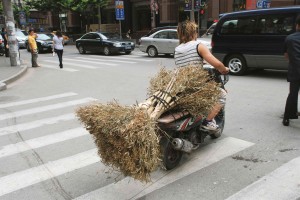

We boarded the ship at night and set sail around 10:00 PM (22:00 – how I have come to appreciate the logic of this much more useful system of time). I felt rather childishly excited to think I was sailing the Yangtze, river of legends.
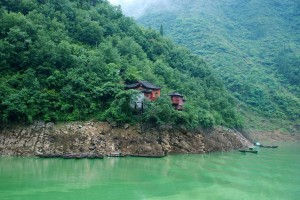
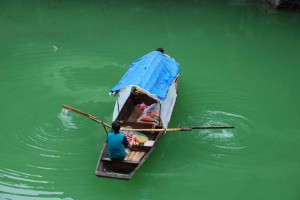
So I have now caught up to where I began this entry, from the decks of the ship. It has rained on and off, leaving bands of mist to dance along the cliff sides in constantly changing patterns. We spent the morning in the first gorge, Xiling Gorge, wherein we transferred from our larger cruiser to a smaller boat to navigate the Xiangxi tributary. Several hours upstream, we debarked and boarded very small 18-person wooden boats, manned by 6 rowers (four bow and two astern). These rowers stand, rowing with single oars that look more like planking than oars. One stands on the bow with a bamboo pole, prodding the bottom when near the shallows, while the captain mans the back oar that is both tiller and oar. It’s a tradition that is centuries old.
When we reached an area too shallow for the oars, four of the oarsmen hopped into the water, donning cane-woven rope and harnesses, wherein they began the even older tradition of tracking, pulling the boat upriver through treacherous rapids or shallow waters. As they struggled for footing in the waters, I was reminded of a video I show in my classes that reveals early 1900’s loin-clothed, sinewy “trackers” climbing high on the cliff sides, perhaps a hundred of them, all roped together, bent nearly horizontal in a slow motion lunge as they drag along whatever ship would not make it upriver on its own accord. If one were to slip and fall, which obviously was not uncommon in this misted land, the others were obliged to cut his ropes, sending him to death down the cliff and into the river. I was surprised that remnants of this mode of passage still exist.
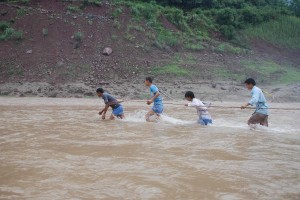
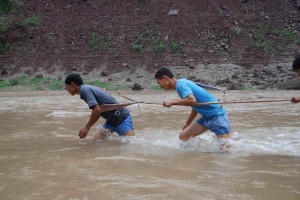
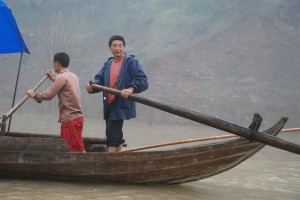
We cruise now along the second gorge, Wu Gorge, created by jagged peaks with names such as Goddess Peak. Its banks are lined with farms, clinging like vines to hillsides seeming untillable. Coal mining has been the economic mainstay of this area, several mines of which have been recently dismantled and abandoned in preparation for the full activation of the dam and the filling of the reservoir. Some of these mines will find themselves submerged, a disturbing thought to environmentalists worldwide. But evidence of rather thoughtful dismantling was apparent.
The third gorge, Qutang Gorge, was as spectacular as the others and is the narrowest of the three. Sadly, many of the historic sites, inscriptions, and all have been submerged, drowning thousands of years of maritime history.
I will write a much longer story for publication about the River at a later time, but here is an encapsulated version of the River and the controversial dam. In order to control flooding and provide hydroelectric power generation, China has for decades looked for ways to tame the Yangtze. Needing a suitable location with just the right contours and geology, the task did involve extensive analysis. It seems the hard, granitic composition of the mountainsides near Yichang provided the best option. The problem was the proximity to the famed and beautiful Three Gorges, whose rugged narrowness made them one of China’s national treasures. Just how their flooding and the subsequent rise in water level would affect these gems was of enormous concern. But the project is now one year from completion and is hailed as the world’s largest dam.
The River has been tamed, much to the dismay of many, even to many Chinese, mostly because of the enormous environmental impacts. But that awaits another story. The project itself is impressive and involves a dam not so massive in height as some of the Western US dams, but certainly massive in width, at what was originally designed to be 1.3 miles. Upon seeing the span, however, I have found that its touted width is broken by several sections of carved-out land. A five-lock canal system operates much like the famed Panama Canal, allowing for major barges and ocean-going vessels to travel up river in about five hours. No such provision was made for the imperiled sturgeon fish, however, which are currently bussed upriver due to nonexistent fish ladders. A lift (small boat elevator) is scheduled for completion by 2012.
Looking merely at the achievement this dam represents, China is certainly to be applauded. It is an engineering marvel whose costs rolled it at $27 billion. Our cruise was comprised of mostly Chinese tourists, both a statement about increasing Chinese wealth and about the fame of this project and the Gorges.
The tour of the dam itself was a let down and I was laughed at when I asked if there was not a component that included viewing the massive French turbines. Apparently security is a big factor and no flights are allowed over the area for a broad distance. Our belongings were x-rayed upon park admission. I call it a park because it was really more a monument to the achievement rather than an explanation of the science behind it all (note the at-least 10-foot-tall book sculpture that was more of a photo draw than the dam itself). A viewing area held a massive display model of the whole project and other sites had viewing points of the dam itself, dotted with an environment garden touting the accomplishments of this project, including how it will significantly improve the overall environment. This latter concept is a bit lost on those of us who have studied the extinction of a dolphin species, the submerging of unexplored archeological sites dating back to some of China’s earliest history, the major problem of sediment load, and endless other consequences of damming the world’s third longest river (Nile, then Amazon).


But this is part of China’s development and it has already brought promise to a previously more isolated interior. That it has flooded out the livelihoods and homes of 1.3 million people so far is part of the ongoing history. Relocation has brought about some unexpected benefits and probably helps the young more than the old, who have lost their ancestral history.
But I have run out of time for more details. Our ship has since landed and I have finished this tale from the comfort of an air conditioned hotel.
Because of the tragic earthquake, my route has been changed some, since I cannot get into Sichuan Province and Chengdu. I leave today by northbound train for Xi’an, home of the terra cotta warriors, and then head east again to the infamous Shoulin Monastery and later Shanghai. From Shanghai I will head for Beijing. And from that point I will head west along the Silk Road to meet with my guide there. That will take me all the way across China into a very different part of China, a part that is more Central Asian in character than Chinese and where the culture is predominantly Muslim. On my return, I will also explore the more Buddhist parts of Tibetan China, without making the journey into Tibet itself, given its current controversy at Olympics time. But the culture extends down the Tibetan Plateau and I will be able to immerse myself in its wonders.
I will continue to make postings like this when time permits, but am saving the details and more complex analysis for futures essays.
Off for another train, hopefully one more like the first. No time to pretty up this entry with its mixed tenses or to catch the typos. Below are a variety of images of places not yet written about…especially Shanghai, Shaolin area, and other eastern/central locales.
____________________________________

